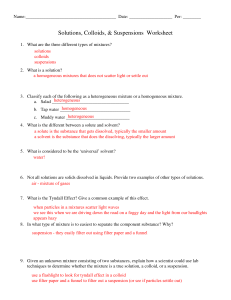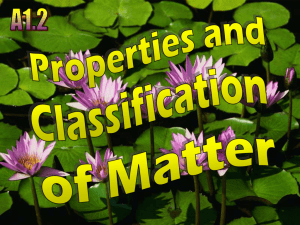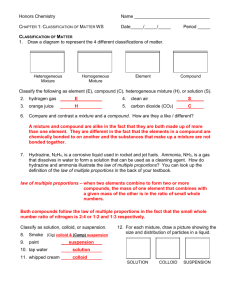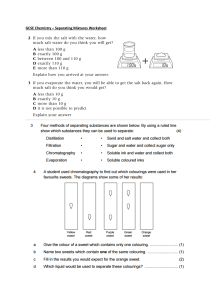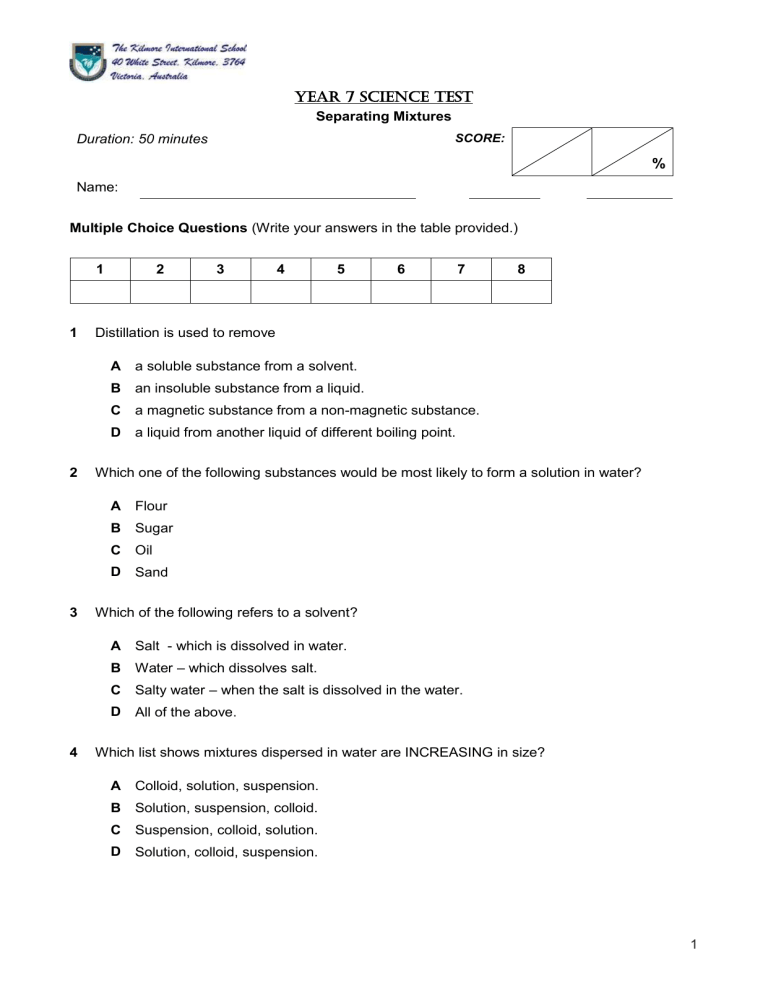
Year 7 SCIENCE test Separating Mixtures SCORE: Duration: 50 minutes % Name: Multiple Choice Questions (Write your answers in the table provided.) 1 1 2 3 4 5 6 7 8 Distillation is used to remove A a soluble substance from a solvent. B an insoluble substance from a liquid. C a magnetic substance from a non-magnetic substance. D a liquid from another liquid of different boiling point. 2 Which one of the following substances would be most likely to form a solution in water? A Flour B Sugar C Oil D Sand 3 Which of the following refers to a solvent? A Salt - which is dissolved in water. B Water – which dissolves salt. C Salty water – when the salt is dissolved in the water. D All of the above. 4 Which list shows mixtures dispersed in water are INCREASING in size? A Colloid, solution, suspension. B Solution, suspension, colloid. C Suspension, colloid, solution. D Solution, colloid, suspension. 1 5 Which of the following separations can NOT be carried out using a centrifuge? A Cream from milk. B Water from wet clothes. C Salt from seawater. D Red blood cells from plasma. 6 Which of the following is a disadvantage of crystallisation? A It always requires heat. B All the solute is recovered. C It cannot be used for insoluble solids. D The solvent (water) is not recovered. 7 Jan tested how well certain substances dissolved in cold and hot water. Her results are shown in the table below. Identify which pair of substances could be separated from each other by dissolving one in hot water and then filtering out the one that did not dissolve. A H and I. B E and G. C G and I. D E and F. 8 Centrifuging is used to separate components in the blood such as red blood cells. What is the property which is exploited in this separating technique? The components……… A colour B solubility C density D shape 2 Structured Questions (Write your answers in the spaces provided.) Question 1 (a) Define the terms filtrate and filtration Filtrate Filtration Residue [3] Question 2 Define the term mixture and provide ONE example A Mixture is …. Example [2] Question 3 (b) State the key similarity between a suspension and colloid? [1] (c) State the key difference between a suspension and colloid? [1] 3 Question 4 Describe the process of decanting. State what TWO properties are exploited for this technique Description of Decanting Property 2 Property 1 [3] Question 5 From the list of the following separation techniques, write the name of the process that can be used to obtain the specific substance from each mixture. Chromatography Centrifuging Crystallization Filtration Process to separate the mixture Wet clothes in a washing machine fine salt particles from muddy water colour from pens e.g. black pen Salt from water [4] 4 Question 4 Some sand is thrown into a solution of sugary water. The sugar is already dissolved in water, but the sand does not dissolve. Describe a two-step method, that you could use to extract clean sugar from this mixture. Step Description of method for each step 1 2 [2] Question 5 List two pieces of equipment that could be used collect a copper(II) sulfate solution. Equipment (1) [2] Equipment (2) Question 6 State ONE everyday example of each of the following mixtures. Mixture Example Colloid Emulsion Solution [3] 5 Question 7 a) In your own words carefully explain the 5 step process of distillation. [5] 6 Question 8 A chemist investigated some ink using paper chromatography. The diagram below shows her results. (a) Describe how paper chromatography works. [2] (b) State the colour that moved the slowest. [1] (c) State the colours present in the mixture. [1] END OF TEST 7

